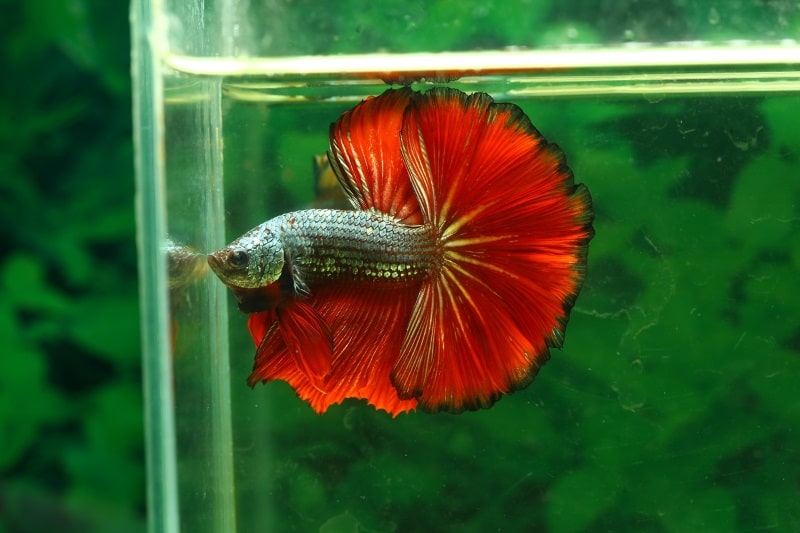Betta Fish FAQ
The most popular type of fish in homes throughout the world is arguably the Betta fish. It is an amazing fish that exhibits a vibrant personality and has the most magnificent fin and color structure (IMHO) that helps create a truly mesmerizing and beautiful aquarium that you will be proud to show off to all your guests.
Betta fish originated from the Vietnamese rice paddy fields and are truly amazing fish. Below you will find answers to the 10 most popular questions that people regularly ask about Betta Fish.

-
How Can You Prevent Betta Fish from Fighting?
The first way is to invest in a larger betta fish tank. If you have a larger tank you will be able to include more plants being very careful not to overdo it or else you risk ruining your fish. If you make the fish tank larger and introduce several more plants, you will be creating additional places for your Betta to hide in case an aggressive one is on the war path.
The second way is to just separate any aggressive fish from the rest. You can do this by using a divider in your tank or just taking the aggressive fish out and then put it in a different tank. The divider is the most recommended option if the tank size allows since that Betta fish will know that the rest of the Betta fish are still present. It also helps with breeding since introductions will already have been made.
Thirdly, it is important never to put two male Betta fish in the same tank. If you do, they might end up fighting to the death, which is the reason why they are also referred to as Siamese Fighting Fish. If you don’t keep two or more males together, you will significantly reduce fighting.
Finally, it is important to be aware of the fact that female Bettas tend to be quite aggressive and fight among each other especially if you have two in one tank. However, this is not something to worry about because it is just a minor leadership tug of war going on between then and soon wears off. A technique that you can use quite successfully to ensure that this never happens is to introduce a third female in the tank. If you do this, any tension that might have existed between the first two disappears. Just try it and you will be pleasantly surprised by how effective it actually is.
-
Is It Advisable to keep Both Female and Male Bettas Together?
Yes, it is. However, as a precautionary measure, you need to keep close watch on the male Betta in case he exhibits too much aggressiveness that you have to remove the female. As previously mentioned having more plants in your fish tank provides a good hiding spot for females in case the male exhibits aggressive tendencies.
-
How Can You Tell a Male and Female Betta Fish Apart?
If you are like most people, you probably have problems recognizing the difference between a male and a female Betta fish. However, the reality is that it isn’t too hard to distinguish one from the other. All you need to do is take note of the information provided below.
The first thing you will note is that female Betta fish tend to have fat bellies while male betta fish typically have a more streamlines structure. If you look closely, you are also likely to note that the males tend to have longer fins and bodies while the females are shorter both in terms of fin length and body size.
Male Bettas also usually have more color as well as longer pointed anal fins in comparison to the female Bettas. You will also note that the anal fins in female Bettas tend to be more level to their bodies. The anal fin is the rigid looking fin that comes from the bottom of the Betta fish.
One dead giveaway guaranteed to help you identify female Bettas is the white spot on the underside of the belly. The white spot is referred to as the ovipositor and is used during breeding.
Yes, it is. However, as a precautionary measure, you need to keep close watch on the male Betta in case he exhibits too much aggressiveness that you have to remove the female. As previously mentioned having more plants in your fish tank provides a good hiding spot for females in case the male exhibits aggressive tendencies.

-
What Are the Best Care Tips for Bettas?
A lot of books have been written on the subject of caring for Bettas, but here are the best tips for a successful betta fish tank;
- Regularly test the acidity level of the water in your fish tank. Ideally, the pH level should be 7 since this is what works best.
- Regularly clean your fish tank, preferably twice weekly. Ensure that you get rid of the bits of food that get caught under the castles, stones, or leaves of the tank.
- Always keep a cover or lid on top of the fish tank with air holes in it because Bettas are capable of jumping and you will not always be there to catch them.
- It is advisable to use a gallon for every Betta fish in your fish tank. You should also try getting a spacious aquarium so that your Bettas have sufficient room to show their personality. You will definitely be surprised because some are incredibly exciting to watch.
- Always keep the filtration system at a low level and take care not to put the air intake in such a way that it exposes your Betta fish to harm. Having the filtration system at a high setting tends to cause make Bettas stressed.
- Always try to maintain the temperature of the water at between 76 and 84 Fahrenheit. It is advisable to use a floating thermometer to test this regularly since the fish easily get stressed by large changes in water temperature. Floating thermometers provide the most accurate reading since they are kept in the tank water.
If you implement the tips provided above, you are guaranteed to have the best Betta fish possible.
-
What Should You Feed Bettas?
Betta fish are surprisingly known to be fussy eaters, which is why you should ideally feed them on a variety of foods including:
- Powder Fish Food if feeding dry
- Combination Betta Pellets found in Pet Stores
- Frozen Bloodworms
- Daphnia
- Brine Shrimp
- Blackworms
- Vegetables (such as green beans in tiny portions)
It is advisable to adopt a regular feeding pattern of 2 to 3 times daily works great for Betta fish. You also need to ensure that all portions are consumed in a single sitting because leftover food can lead to additional bacteria in the fish tank that can potentially cause disease for the Betta fish.
-
What Are Bettas Also Known As?
Not too many people are aware of this fact but Bettas are also referred to as Siamese Fighting Fish. The name comes from the aggressiveness of the males as well as their “Fight to the Death” attitude in case two males are put in one tank together.
Bettas are often referred to as Betta Splendens. However, this is a name of a type of breed of Betta that conveniently leads to the question below…

-
How Many Different Types of Betta Fish Are Available?
Betta fish are of many different types, but the most popular ones are listed below:
- Betta Picta
- Betta Coccina
- Betta Bellica
- Beta Splendens (most common)
The most popular Tail Types of Betta include:
- Fan Tail (It displays a smoothly rounded edge)
- Pin (Spade) Tail (It is pointed at its end)
- Super Delta Fish (Typically any Betta whose tail span is between 120 and 180 degrees)
- Veil Tail (It is generally the most common type of tail found at pet stores)
- Delta Fish (Typically any fish below the 180-degree tail span)
- Half Moon (It is a tail that’s shaped like a half moon �” a 180-degree span. It is the fish that most breeders aim to achieve and display an amazing color?
Depending on what your requirements are this should ideally give you sufficient information to help you choose a Betta at the pet store.
-
Are You Allowed to Put in Bamboo with Your Betta Fish?
Bamboo, which is the type found in pet stores can be put in the fish tank with your Bettas. It makes the tank look more appealing and attractive to guests, which is always a good thing.
However, ensure that the bamboo is thoroughly cleaned before you put it in your tank to make sure that it doesn’t have any chemicals on it capable of hurting your Betta. It is also advisable to regularly check on the bamboo to check whether it is rotting to avoid releasing bacteria into the water in your fish tank that may potentially harm your Bettas. Regularly changing the water in your fish tank reduces the threat of bacteria.
-
What Ammonia Level Should the Fish Tank Be At?
The ideal level of ammonia is between 0 and 0.5. If you regularly change the water in your tank i.e. Between 30 and 50 percent twice weekly if the ammonia is high, you can reduce the ammonia present in the tank.
It is advisable to regularly monitor the ammonia levels since very high levels aren’t healthy for Bettas.
-
Can a Father Betta Fish Harm His Children?
The unfortunate thing is that a male Betta (whether a father or not) is capable of harming children Bettas. While the Father Betta us usually quite protective of the Fry during the process of spawning, they often attack the Fry as they grow larger and capable of looking after themselves.
It is advisable to remove the Father from the tank once the Fry become capable of swimming freely, which is between 7 and 10 days after birth since he has become quite aggressive towards them and may potentially cause them harm.
The Bottom Line on The Betta Fish
The 10 questions answered above are the most common ones that people have about keeping betta fish. Hopefully, the information provided here has been useful to you and that you will put it to good use.
